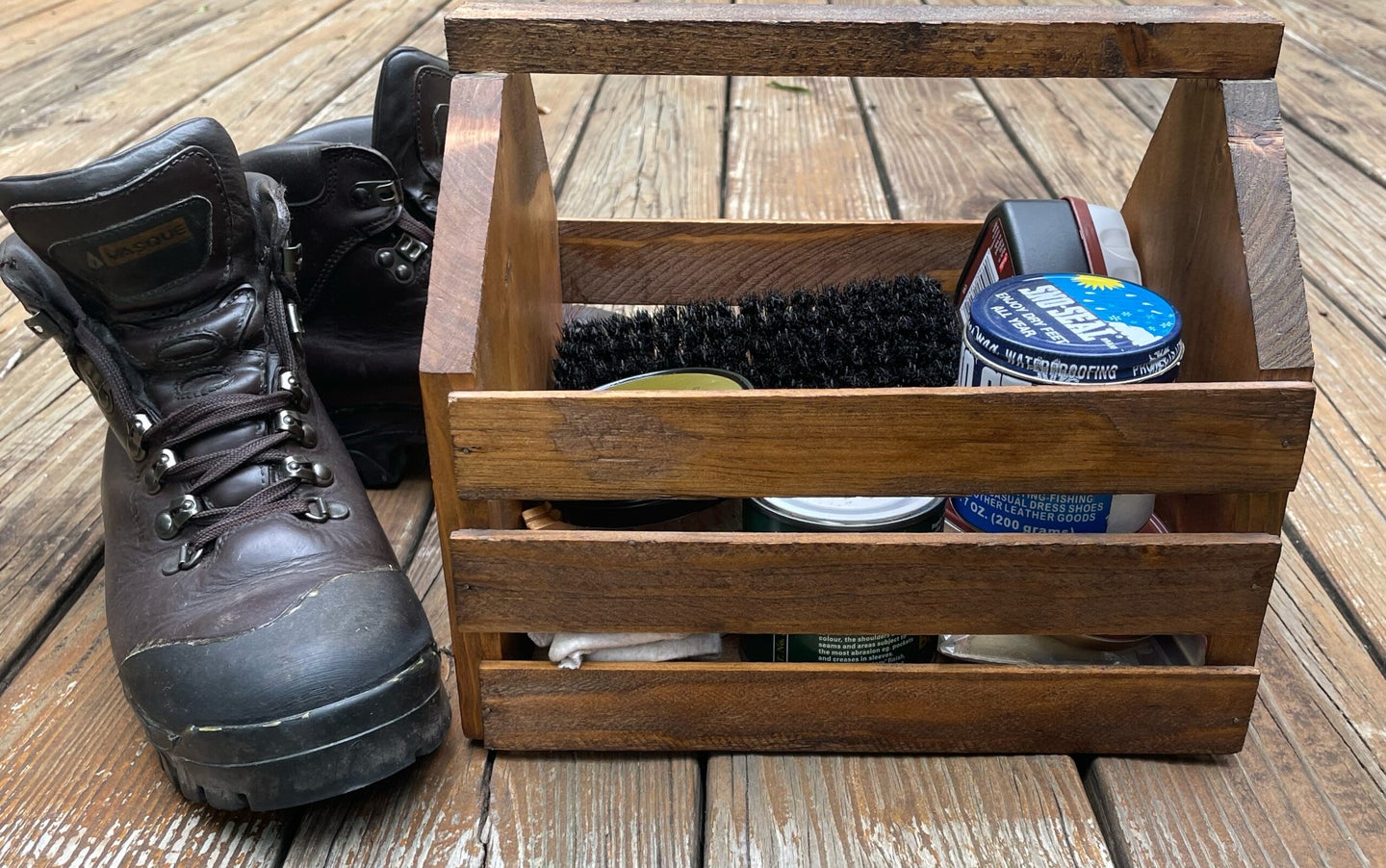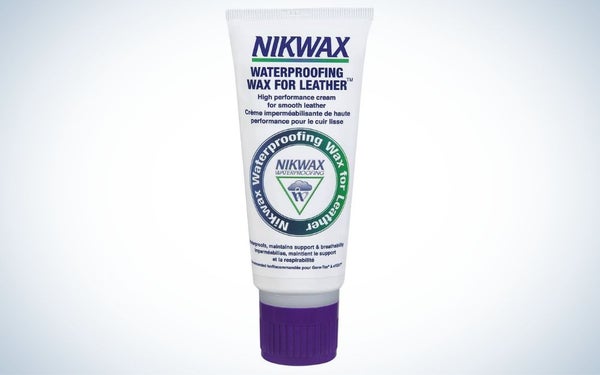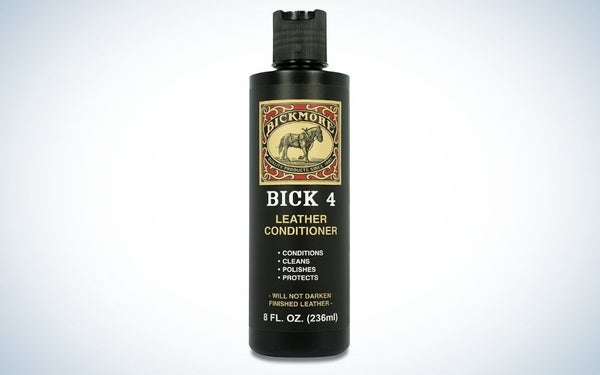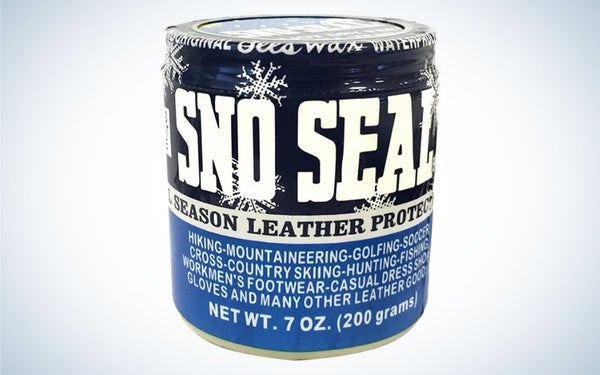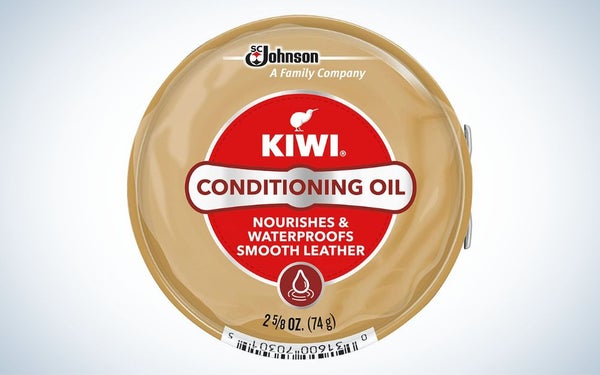| Best Overall |
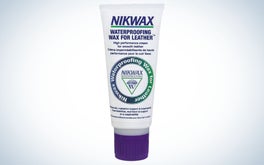
|
Nikwax Waterproofing Wax for Leather | SEE IT |
LEARN MORE
|
Summary
Wax cream that both conditions and waterproofs leather |
| Best Waterproofing |
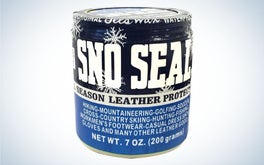
|
Atsko Sno-Seal Wax | SEE IT |
LEARN MORE
|
Summary
Extremely effective wax waterproofing treatment |
| Best That Won't Darken Leather |
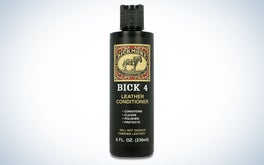
|
Bickmore Bick 4 Leather Conditioner | SEE IT |
LEARN MORE
|
Summary
The best oil for maintaining quality leather without changing its color |
We may earn revenue from the products available on this page and participate in affiliate programs. Learn more ›
A good pair of leather boots is an investment that deserves the best oil and waterproofing treatment. Whether you hike, hunt, fish, or spend any time outdoors, you rely on your boots to get you there and home again safely. A properly cared for leather boot keeps your feet protected and dramatically prolongs the lifespan of the boot. Proper cleaning and oiling will keep your expensive leather boots in great shape and allow you to make the most of your time afield. Maintaining your boots with one of the best leather boot oils will keep your feet dry and save you money in the long run.
Over time, the elements take a toll on natural materials like leather. Too dry, and the leather will crack and desiccate. Too wet and the leather will saturate and rot from the inside. The best leather boot oil can prevent damage, but also repair, and restore boots that have seen better days.
With so many types of leather and different products to choose from, picking the best boot oil can be a challenging and confusing undertaking. We’ve compiled a list of the best oils for leather boots on the market for every type of boot and outdoor activity to help you make the most informed decision and keep your feet happy and your boots on the trail for many more miles.
- Best Overall: Nikwax Waterproofing Wax for Leather
- Best That Won’t Darken Leather: Bickmore Bick 4 Leather Conditioner
- Best Waterproofing: Atsko Sno-Seal Wax
- Best on a Budget: KIWI Outdoor Conditioning Oil
Things to Consider Before Buying oil for leather boots
Type of leather
It’s important to understand the qualities of the leather you’re working with when picking the best leather boot oil. Smooth, hard leather boots designed to take abuse and repel water require a different type of treatment than rough, soft, and suede leather. Light, non-staining oils and polishes are generally used for more delicate leather boots and casual and dress shoes. Hard leather boots made for hunting, hiking, or work need an oil that both penetrates the leather to make it supple as well as one that provides waterproofing so moisture beads off rather than saturates.
Viscosity
Leather boot treatments come in a variety of forms, from liquid to cream, grease, and more. Liquid oils are generally better at penetrating and restoring dry leather cowboy boots and similar soft leather footwear. Grease, wax, and more viscous treatments are often made to provide longer-lasting waterproofing as well as a glossy exterior on hard leather work boots and those destined for the mountains.
Ingredients
Boot oils and conditioners are made from many different natural and synthetic materials. Some natural ingredients such as mink oil, beaver oil, beeswax, and propolis are very shelf-stable, and their natural water relling makes them an excellent choice for treating leather boots. While mink oil is a fantastic leather conditioner and waterproofer, most mink oils on the market only contain a very small percentage of actual mink oil. Raw mink oil is prohibitively expensive, and ethically questionable when sourced from overseas fur farms. Domestically sourced mink oil that is a byproduct of the fur trapping market is far more humane, but may be hard to find and costly.
Leather boot treatments that include wax tend to be far superior in terms of water repellency because they form a thick layer to block water from coming in. Wax can also make it harder for moisture to evaporate and work its way out, so it may affect a boot’s breathability.
Synthetic ingredients such as silicon, chemical solvents, and petroleum-based products are also very shelf-stable and will not decay over time, making them great choices for treating leather boots. Some chemical and synthetic ingredients may have a chemical odor or dry out leather over time, so that is also something to consider. All that said, many of the best oils for leather boots are treatments that utilize a blend of natural and processed ingredients.
Waterproofing
While the best boot oils provide some degree of water repellency, some are designed more for softening, restoring dry leather, or polishing, rather than serious waterproofing. If you want the best, longest-lasting waterproofing it’s important to pick the right oil or combination of products to achieve the desired result. In general, wax-based treatments are the best at waterproofing.
Discoloration
Many boot oils will darken and change the color of the leather once applied. In many cases, this is a desirable outcome, and boot makers anticipate that their boots will end up a darker, richer color when choosing leather. This is something for the consumer to consider when picking an oil if for whatever reason you want to maintain the original, natural hue of your leather footwear or other products.
Best Overall: Nikwax Waterproofing Wax for Leather
Why It Made the Cut
Nikwax waterproofing wax is by far one of the best conditioners and waterproofing treatments on the market for leather boots. It is affordable, easy to apply, long-lasting, and unmatched in water repellency.
Key Features
- Wax based waterproofing
- Paste form
- Maintains breathability on Gore-Tex and similar material
Pros
- Outstanding water repellency
- Easy to apply
- Environmentally friendly
Cons
- Sponge applicator
- Wax buildup
Nikwax waterproofing wax is the best overall leather conditioning and waterproofing solution I have used. Nikwax is well known for their excellent waterproofing and cleaning products, and their boot wax is no exception.
Nikwax waterproofing wax both conditions leather by restoring tanning agents, and it provides exceptional waterproofing. Tanning agents are added to leather during the leather-making process to break in the leather, give the leather structure, as well as inhibit microbial growth that would accelerate the rate of decay. Nikwax helps to replenish these tanning agents that are lost over time, as well as provides a fresh DWR (Durable Water Repellency) coating. Nikwax does this without compromising breathability. Leather is a porous material, and a good leather boot is built to be breathable. Unlike some waterproofing products that leave a coating that blocks moisture from escaping, Nikwax maintains breathability so moisture can evaporate from the inside but not penetrate from the outside. This helps to keep your feet dry from both the exterior environment, as well as sweat and condensation that build up in the interior. Nikwax waterproofing wax does not contain solvent-based waxes, aerosols, volatile organic compounds (VOCs), or water-based fluorocarbons that are both flammable and bad for your body and the environment.
Unlike some competitors’ products, Nikwax can be applied to both wet and dry leather. Though dry is the better choice, you can count on it to restore waterproofing in a pinch, even in wet conditions. The wax is easy to apply and not runny like traditional liquid boot oils. Nikwax waterproofing wax comes in a squeeze bottle with a sponge tip that you simply rub on the boot to apply the wax. The sponge tip is Nikwax’s only downfall, as it gets dirty, ripped, and worn out quickly. A standalone application tool, whether included or sold separately would have been a better option. You can also use a clean sponge, rag, or even your fingers to apply the wax. The wax can collect along seams and leave a tan waxy residue if overapplied. Using a hair dryer or leaving your boots next to the woodstove for a few minutes is usually enough to melt the excess wax and allow you to work it back into the leather.
Nikwax waterproofing wax for leather boots is extremely affordable at under $10 for a bottle that will last several full applications. Every hunting season I treat all of my leather boots with Nikwax waterproofing wax to keep my feet dry and my boots in great shape.
Best That Won’t Darken Leather: Bickmore Bick 4 Leather Conditioner
Why It Made the Cut
Bickmore Bick 4 Leather Conditioner stands out among so many other oils and boot treatments that leave waxy residue and change the color of the leather. It’s the best product for hand-crafted leather items that you want to maintain or restore without altering.
Key Features
- Will not darken leather
- Wax-free
- Made in the USA
Pros
- Will not change the color of leather
- Non-glossy or oily
- Conditions and softens leather
- Maintains breathability
Cons
- Less waterproofing
- Unknown ingredients
Bickmore Bick 4 Leather Conditioner is the best leather boot oil that won’t darken your leather. If you’ve splurged on a high-end pair of cowboy boots or quality leather product that you want to condition without discoloring, the Bickmore Bick 4 conditioner is the choice for you.
Since 1882 Bickmore has been making horse and leather care products. The Bickmore family and company have a fascinating history which began as a cottage industry and has grown into a wide catalog of equine and leather care products. Today, their well-established and closely guarded formulas are trusted by discerning horse nerds and leather enthusiasts alike. All of their products are still made right here in the USA.
Bickmore Bick 4 Leather Conditioner works on a huge variety of premium smooth leather products from footwear, to clothing and accessories, upholstery, automotive interiors, equestrian equipment, and more. It is not intended, however, for use on suede, rough, distressed, or napped leathers. The ingredients in Bick 4 are a closely guarded secret, but we do know that it does not contain wax or silicone and is made from a proprietary blend of emulsifiers, conditioners, and moisturizers. At around $15-20 for a 16-ounce bottle, it’s about on par with other boot oil prices in terms of price per ounce, although it’s a slightly higher initial cost than some.
Not only is Bick 4 designed to clean, polish, and protect everything from cowboy boots to fine leather saddles, but it does so without compromising the original color of the leather, or making it oily and waxy like many other leather conditioners on the market. While it does improve the hydrophobic quality of leather, Bick 4 is much more of a conditioner than a waterproofing agent. It acts much like a moisturizer, keeping leather soft and supple. Because it does not contain wax, Bick 4 is not nearly as water repellent as some of its competitors. However, because of this, it will also not leave a glossy polish or sticky residue, nor will it clog the leather’s pores and reduce airflow. This allows boots treated with Bick 4 to maintain their breathability. If you want additional weatherproofing, Bickmore recommends using the Bickmore Gard-More after conditioning for extra protection and waterproofing.
Best Waterproofing: Atsko Sno-Seal Wax
Why It Made the Cut
If I needed to grab my boots to go anywhere in the world, Sno-Seal should be the next thing I’d reach for. It’s made to shed water and take abuse and does so phenomenally well.
Key Features
- Beeswax formula
- Heavy-duty waterproofing
- Shelf-stable
Pros
- Highly water repellent
- Mostly natural ingredients
- Shelf-stable
Cons
- Sticky
- More waterproofer than conditioner
Sno-Seal is the best waterproofing oil for outdoorsmen and women. It’s not really an oil, but a beeswax compound that provides unmatched waterproofing and protection from the elements. Unlike many other boot oils, with Sno-Seal there are no weird chemicals to worry about or organic fats to go rancid and ruin your leather. It is more or less just wax with a solvent to make it softer and easier to spread. Beyond leather boots, Sno-Seal works great for leather gloves, waxed cotton clothing, canvas tents, and more.
Sno-Seal is more of a waterproofing treatment than a traditional leather conditioner. The natural oils in the wax will help to preserve and condition leather but it is not as effective at softening and conditioning as dedicated conditioning products. That being said, Sno-Seal is extremely good at protecting the leather from absorbing moisture and keeping your boots safe from becoming damp and deteriorating over time. Treated with Sno-Seal, your gear will stay much drier and lighter in the field as it is not holding onto water weight. With a properly treated pair of boots, you should have no problems crossing a creek, walking through the snow and rain, or traversing a field of tall wet grass. Water beads off like nothing with Sno-Seal and you would have to absolutely soak your boots for a long time for them to start to become saturated.
I have personally used and recommended Sno-Seal for many years for hunting and work boots. The wax formula may not penetrate the pores of the leather as deeply as some boot oils, but it creates a pretty impenetrable wax layer that sheds water and protects the outside of your boots from wear and tear.
Atsko, the company that produces Sno-Seal, claims that their products maintain breathability for boots that utilize Gore-Tex by allowing moisture from perspiration to escape. Having used Sno-Seal for many years I am somewhat skeptical of this claim due to the way in which the wax coats the leather and creates an outer layer of water repellency. Still, Sno-Seal is trusted by many extreme outdoor athletes, mountaineers, and climbers who rely on breathable footwear.
Sno-Seal is rather inexpensive, costing roughly $10 for 7 ounces of wax. One package will likely last you several years of use. Like other wax-based treatments, I recommend slightly warming it before applying. Make sure the boot is as clean and dry as possible and rub the soft wax into the leather thoroughly with a cloth rag or gloved hand. For the best results, apply several coats allowing drying time between applications. If there’s excess wax buildup you can warm the boots with a hairdryer and work the extra wax back into the leather. Sno-Seal will darken and apply a shiny, polished outer coating to boots so keep that in mind if you wish to maintain the leather’s original color and gloss.
For most leather hunting and work boots, a few coats of Sno-Seal should be all you need to keep your boots conditioned and watertight. In some cases, you may want to use Sno-Seal in conjunction with another leather conditioner, preferably one without solvents that could degrade the wax.
Best on a Budget: KIWI Outdoor Conditioning Oil
Why It Made the Cut
KIWI Outdoor Conditioning Oil can be found just about everywhere and provides great bang-for-your-buck conditioning and waterproofing.
Key Features
- Deep penetrating
- Conditions and softens leather
- Water repellent
Pros
- Inexpensive
- Widely available
- Cleans and conditions
Cons
- Contains solvents and silicone
- Darkens leather
KIWI Outdoor Conditioning Oil is the best boot oil for those on a budget. Widely available, and for about $5 a tin, KIWI conditioning oil is an accessible and affordable solution for maintaining your boots and other leather products.
KIWI conditioning oil is mainly intended for smooth leather and works to repair, condition, and provide a degree of water repellency. It’s great for maintaining and wearing-in boots and other leather products. If you have an old pair of leather boots or gloves that have dried out and cracked over time, a liberal dose of KIWI conditioning oil can go a long way to restoring them to their former glory. Much like a skin moisturizer softens and replenishes rough skin, KIWI conditioning oil brings leather back to life.
While the ingredients are not listed on the can, a little research reveals that Kiwi Conditioning Oil is made from a combination of paraffin, silicone, and chemical solvents. Paraffin wax acts as a waterproofing and softening agent. It is softer and easier to spread than heavy beeswax, but it is not as effective at repelling water. Silicone also provides waterproofing and helps the other ingredients bond to the leather. The various chemical solvents used in the Kiwi oil are more or less used to clean and condition the leather and provide a good base for the paraffin and silicone to do their thing. The solvents help the other ingredients penetrate the leather, then evaporate. There is some back and forth discussion on whether solvents and silicone have a tendency to dry out leather, as well as environmental and health questions. Still, they are widely used and generally considered perfectly fine.
At room temperature, Kiwi Conditioning oil is more like a hard wax than an oil or cream. It’s not a bad idea to warm the tin slightly in a hot water bath or with a hair dryer before use so the oil is softer and spreads more easily. Kiwi Outdoor Conditioning Oil will darken leather once applied, so keep that in mind if you wish to maintain the original color of your items.
How I Made My Picks
As a lifelong hunter, fisherman, and general outdoorsman, I have gone through many pairs of boots and countless bottles of leather boot oil in my time. I spend hundreds if not thousands of hours outdoors each year chasing critters, running around for fun, or in the field in some capacity for work. I rely on my boots to keep my feet comfortable, dry, and safe both in the outdoors and when going about my daily life. I know firsthand the issues wet boots and wet feet can cause. I have worked as an outdoor guide and spent many years in outdoor retail learning about the various products on the market for cleaning, maintaining, restoring, and weather-sealing leather boots, gloves, and other products. Then, and now as an outdoor writer and communicator, it’s my job to know how this stuff works and what the differences are between the various available products. For this roundup, I drew on my extensive personal and professional experience in the outdoors to identify and highlight a handful of the best oils for leather boots on the market. All of these products I have either personally used, or have no problem recommending after thorough research.
FAQs
Q: How do I keep my leather boots from cracking?
The best way to keep leather boots from cracking is to keep them clean and well oiled. Much like our own skin, being too wet or too dry for too long will lead to cracking. Too wet and the leather oversaturates and softens too much, weakening the leather and causing it to crack. Too dry, and the leather cannot bend and stretch under strain. Eventually, small tears and cracks will form and grow larger over time. Well-oiled leather repels harmful moisture and remains lubricated and supple enough to bend and stretch.
Q: How much does oil for leather boots cost?
The best oil for leather boots is extremely affordable. Most leather boot oils, conditioners, and waterproofing treatments sell for $10 to $20 a bottle. You can expect to spend around $1 to $3 per ounce for the overwhelming majority of boot oils, with some high-end niche oils selling for considerably more. For the average person who engages in occasional to frequent outdoor recreation, expect one bottle or tin of oil to last you one to two years or more. You’ll likely go through more waterproofing than conditioning oil in the same amount of time unless you’re restoring something that really needs some love.
Q: Is coconut oil good for leather shoes?
Coconut oil is a terrible choice for leather. Many naturally-derived oils like olive oil, canola oil, coconut oil, etc., will actually accelerate the rate of decay of leather. Some animal fats are in the same category and will turn rancid over time. These natural oils generally hold some amount of organic matter that is not shelf-stable and will deteriorate over time, degrading the leather as it does.
Final Thoughts
If you spend any time outdoors in leather boots you need the best leather boot oil you can find. Picking the right product, or combination of products to keep your boots clean, dry, water repellent, and well maintained is vital to your comfort, health, and success afield.
When looking for the best oil for leather boots, t’s hard to beat wax products like Nikwax Waterproofing Wax or Sno-Seal. If you’re on a budget or want an exceptional conditioner to maintain or restore your boots and other leather products, the KIWI Outdoor Conditioning Oil is an excellent choice. And finally, if you have a fancy pair of cowboy boots, a handcrafted saddle, or an expensive baseball glove that you want to maintain without harsh chemicals, glossy and sticky wax, or changing the natural color of the leather, the Bickmore Bick 4 Leather Conditioner is the best leather oil for your needs.
Ask a seasoned outdoorsman or an experienced soldier what’s the most important thing to care for in the field, and they’re almost certain to say their feet.
Our feet, with our boots, are the vehicles by which we traverse, explore, and experience the world. It’s important to take care of your leather boots so they can take care of you.
